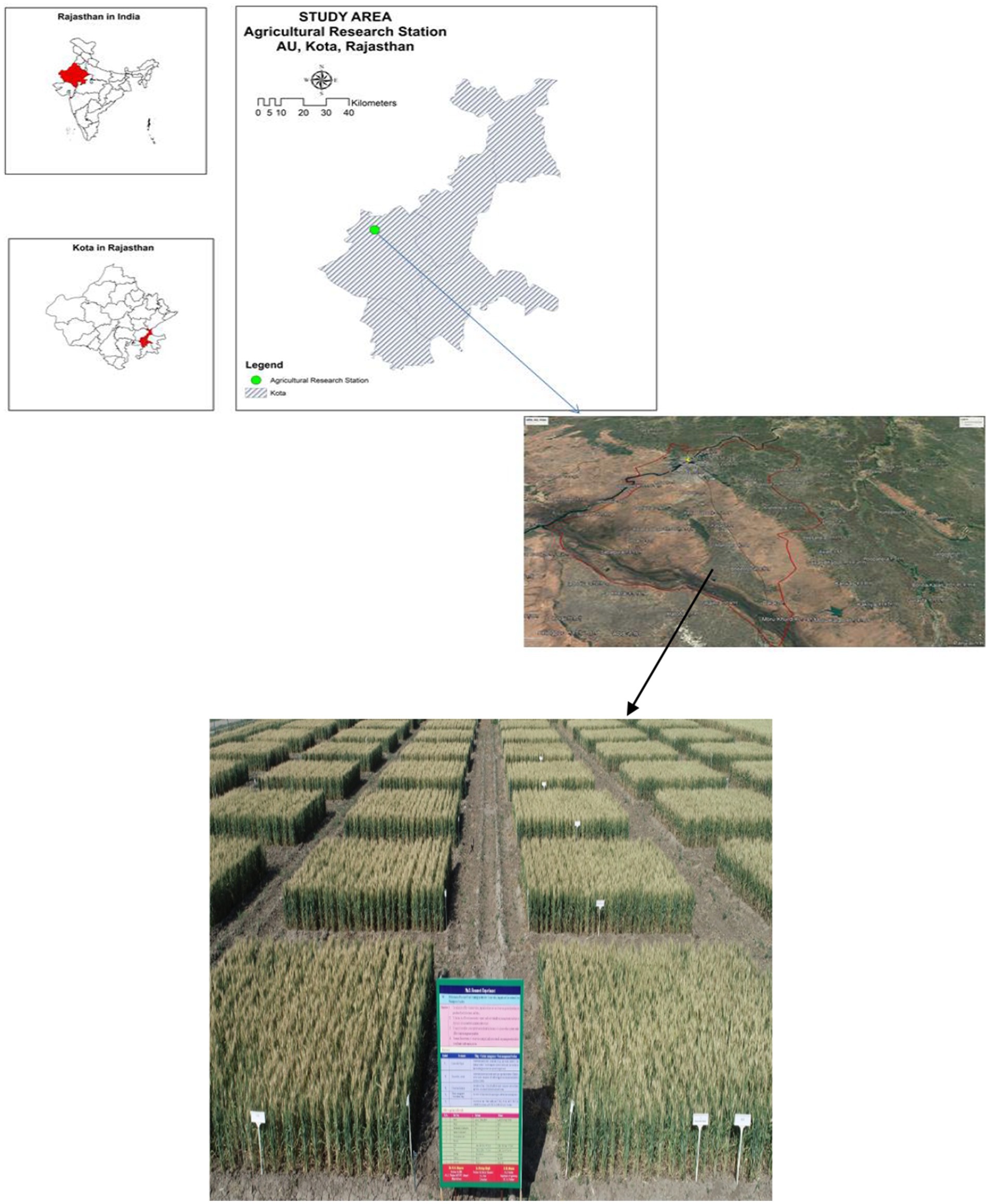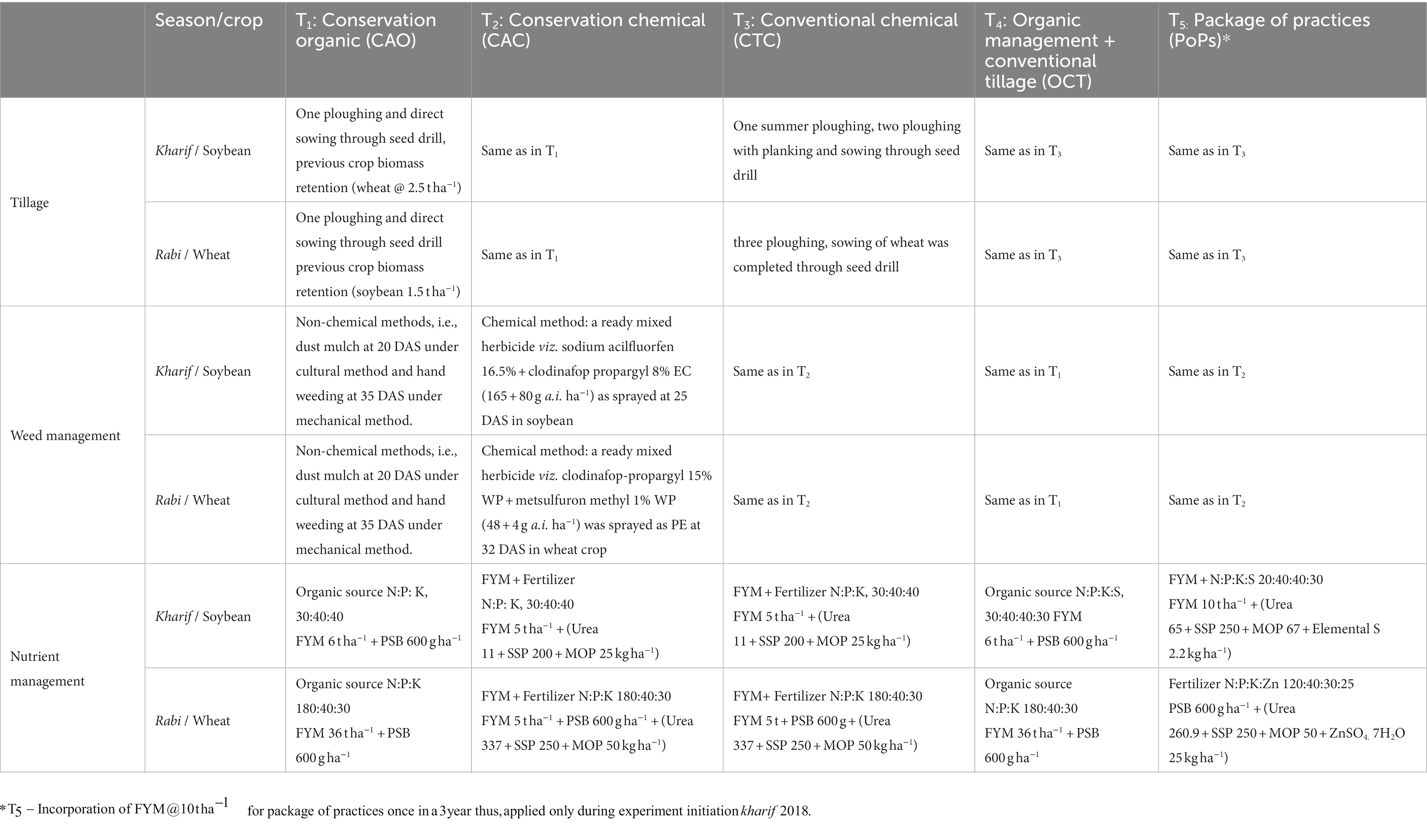- 1Agriculture University, Kota, Rajasthan, India
- 2Indian Council of Agricultural Research (ICAR), New Delhi, India
- 3ICAR-Central Agroforestry Research Institute, Jhansi, Uttar Pradesh, India
- 4ICAR–Indian Institute of Soil Science, Bhopal, Madhya Pradesh, India
- 5Maharana Pratap University of Agriculture and Technology, Udaipur, Rajasthan, India
- 6ICAR–Indian Agricultural Statistics Research Institute, New Delhi, India
- 7Professor Jayashankar Telangana State Agricultural University, Hyderabad, Telangana, India
- 8Savitribai Phule Pune University, Pune, Maharashtra, India
To achieve higher crop production in a soybean-wheat cropping system, comprehensive knowledge of soil fertility status and its variability is crucial. However, a significant gap exists between the potential and actual productivity of this system in the Vertisols of Indian semi-arid tropics. Therefore, 2 years of field research were conducted to investigate how different crop management practices affect soil fertility in this cropping system. The trial was conducted using a randomized complete block design (RCBD) with five crop management practices: CAO (conservation tillage + organic nutrient and weed management), CAC (conservation tillage + chemical nutrient and weed management), CTC (conventional tillage + chemical nutrient and weed management), OCT (conventional tillage + organic nutrient and weed management), and PoPs (package of practices). Results showed that CAO significantly (p < 0.05) increased soil organic C (6.8 g kg−1), available N (129.5 mg kg−1), P (11.0 mg kg−1), K (232.6 mg kg−1), Fe (9.17 mg kg−1), and Mn (10.48 mg kg−1) at topsoil (0–15 cm) and deeper layers (15–60 cm). In contrast, CAC had significantly (p < 0.05) higher soil availability of Ca (5,072 mg kg−1) and Mg (901 mg kg−1) and Cu (0.84 mg kg−1). On the other side, PoPs resulted in the highest S (10.05 mg kg−1) and Zn (0.85 mg kg−1) availability in the topsoil. Our results evidently suggested S and Zn availability as key indicators of soil health sustenance in the present agroecosystem. Notably, CAC had significantly (p < 0.05) higher system productivity (4.62 t ha−1) than the other treatments, showing a 14.0, 6.3, and 18.2% increase over CAO, CTC, and OCT, respectively. Based on the results, it is recommended that CAC is a better option for achieving higher system productivity, while CAO is the best option for ensuring long-term sustainability of soil fertility. The findings of this study could be useful for farmers and agricultural researchers in designing efficient crop management practices to improve the productivity and sustainability of soybean-wheat cropping system in arid to semiarid ecology.
1. Introduction
The soybean-wheat cropping system is one of the 30 prevalent cropping systems in India and is mostly practiced in the semi-arid tropics including the states of Madhya Pradesh, Maharashtra, and Rajasthan (NMOOP, 2014). This cropping system gained importance in the 1980s when soybean was introduced as a kharif (rainy season) crop in the wheat-based cropping systems of India with assured canal irrigation (Ramesh et al., 2017). Soybean and wheat have been vital in addressing food and nutrition security in India (NAAS, 2017). However, system productivity of this cropping system has remained low compared to the national average over the years (Choudhary et al., 2018), particularly in the semi-arid tropical zone of Rajasthan, India. Due to the irrigated ecology, this system productivity is not constrained by soil moisture stress, which is otherwise observed in many parcels of India (Dev et al., 2022; Garg et al., 2022). One of the major factors constraining the productivity of the soybean-wheat cropping system in India is depleted soil fertility and quality (Behera et al., 2007); while the other factors include diseases and pests (Ramesh et al., 2017) and heat stress and/or weather aberrations (Lenka et al., 2016). Soil fertility has deteriorated continually due to mismanagement practices, soil disturbances, and higher nutrient exhaustion caused by high-yielding, input-responsive cultivars of cereals and pulses that have been released since the 1960s (Debnath et al., 2020, 2022). The problem lies in the fact that farmers intensively practice farming in India without appropriate crop management practices, as they are more concerned with monetary returns than caring for soil health (Roos et al., 2018; Sharma et al., 2021). This lack of attention to soil health is adversely affecting crop production, productivity, and the sustainability of soil in the region.
One potential solution to this challenge is to adopt appropriate land management practices that include adequate nutrient management and minimum soil disturbance. The current over-reliance of farmers on inorganic fertilizers to boost crop production without incorporating organic amendments can cause irreparable damage to soil properties and negatively impact the soil environment (Devi et al., 2013). Using a combination of organic and inorganic sources of nutrients can improve soil physicochemical properties, promote the growth of beneficial soil microorganisms, and maintain soil nutrient balance in the cropping system (Zhao et al., 2023). On the other side, conventional tillage practices performed over an extended period can lead to physical degradation of the soil, reduce organic carbon and microbial biomass, and ultimately reduce desirable yield (Singh et al., 2009; Bhan and Behra, 2014). In constrast, adopting conservation tillage practices can efficiently manage the soil for resource efficiency and higher productivity (Carpenter-Boggs et al., 2003; Jayaraman et al., 2021a,b).
There is a growing agreement among experts that conservation tillage practices, such as minimum tillage and residue mulch, have significant benefits for soil health. For instance, minimum tillage leads to improved soil water and carbon storage, better aggregate stability, and increased saturated hydraulic conductivity while reducing bulk density compared to conventional tillage (Jalota et al., 2001; Hati et al., 2015; Dal Ferro et al., 2023). In addition, retaining crop residues in the field has a direct or indirect positive impact on soil quality by reducing soil erosion, conserving soil moisture, maintaining hydrothermal conditions, and increasing soil porosity and infiltration (Zhu et al., 2023). Crop residues also provide energy for the growth and activity of microbes, which increases soil microbial biomass and carbon substrate for microbial biomass (Govaerts et al., 2007; Kätterer and Bolinder, 2023). Therefore, combining conservation tillage with inorganic and organic plant nutrients has the potential to improve soil fertility and crop productivity, which could lead to sustainable development opportunities for a nation like India.
The current fertilization practices in India focus solely on the nutrient needs of the succeeding crops, disregarding the residual effect of applied nutrients on the previous crops. Achieving a balance in nutrient application is crucial for optimizing the output of any cropping system. Globally most of the studies under conservation agriculture were conducted in combination with inorganic nutrients application only. However, there is lack of clear understanding on how conservation agriculture behaves under organic nutrient managements in terms of soil quality improvement and crop yield sustainability. While there have been previous studies on nutrient and tillage management practices in rice-rice (Yadav et al., 2017), rice-wheat (Jha et al., 2023; Dhaliwal et al., 2023a) and maize-wheat (Pramanick et al., 2022; Rani et al., 2023) cropping systems in India, their integrative effect on soil properties and system productivity in soybean-wheat cropping systems remains unexplored. To address these gaps, a two-year field investigation was carried out to examine the impact of conservation, organic, and conventional crop management practices on (i) soil physical and chemical properties, (ii) yield and system productivity, and (iii) key drivers of system productivity in soybean-wheat cropping systems. This study is intended to design efficient crop management practices to improve the productivity and sustainability of soybean-wheat cropping system in the semi-arid to arid ecology of India and many other parcels of the world with similar agroecology.
2. Materials and methods
2.1. Study site characteristics
A two-year field study was conducted at the Agricultural Research Station, Agriculture University, Rajasthan, India (25°10’ N, 75°50′ E, and 267 m above msl) from 2018–19 to 2019–20 (Figure 1). The site experiences a subtropical climate with extremely warm and dry summers (April to June) and wet monsoons (July to September) during the soybean season and cold and harsh winters (November to January) during the wheat growing period. The mean maximum temperature ranges between 40 to 48.4°C during May–June, and the mean minimum temperature ranges between 2.0 to 8.5°C during December–January. The study area receives an annual rainfall of 660.6 mm, with the majority falling between the months of June–September. The experimental soil was moderately deep, well-drained, black Vertisols (United States Department of Agriculture classification), clay-loam in texture (sand 25.86%, silt 35.10%, and clay 38.94%), with neutral in soil reaction (7.41). The pre-crop topsoil (0–15 cm) contained organic C (5.1 g kg−1), available N (104.5 mg kg−1), P (9.4 mg kg−1), K (196.0 mg kg−1), S (7.5 mg kg−1), and DTPA-extractable Zn (0.66 mg kg−1), Fe (6.80 mg kg−1), Cu (0.61 mg kg−1), and Mn (7.21 mg kg−1).
2.2. Treatments and experimental design
The study implemented various combinations of conservation tillage, organic, and chemical management practices, including nutrient and weed management, in a soybean-wheat cropping system. The treatments consisted of five scenarios, namely T1-conservation organic (CAO), T2-conservation chemical (CAC), T3-conventional chemical (CTC), T4-organic management + conventional tillage (OCT), and T5-package of practices (PoPs), which were randomly assigned in a randomized complete block design (RCBD) with four replications (Table 1). The plot size for each treatment was 389 m2 (48 m x 8.10 m). Before sowing the crops each year, well-decomposed farmyard manure (FYM) was incorporated into the soil based on the treatment requirements. The total N content in FYM was determined by Kjeldahl digestion following the distillation method (Jackson, 1973), and the FYM was also analyzed for total P, K, S, and Zn, Cu, Fe, and Mn contents through digestion with an HNO3:HClO4 (4:1) mixture and subsequent determination by vanadomolybdophosphoric acid, flame photometric method, and atomic absorption spectrophotometric method, respectively (Manna et al., 2012). The mean nutrient contents of FYM were analyzed as follows: N (0.50%), P (0.26%), K (0.50%), S (0.03%), Zn (24.80 ppm), Fe (173.90 ppm), Cu (5.15 ppm), and Mn (97.45 ppm). a slightly alkaline pH (7.41).
2.3. Crop management
Table 1 presents the agricultural techniques employed for cultivating the test crops, soybean and wheat, during the 2018–19 and 2019–20 seasons. In the rainy (kharif) season, soybean (cv. RKS 45) was sown using a seed drill in mid-July at a spacing of 30 cm (intra-row) x 10 cm (intra-plant) with a seed rate of 80 kg ha−1 and harvested in the last week of October. The experimental site was then irrigated for field preparation and sowing of the succeeding wheat crop in the winter (rabi) season. Wheat (cv. Raj 4,079) was sown at a spacing of 22.5 cm x 5 cm with a seed rate of 100 kg ha1. Seeding was completed using a seed drill in the first week of December and harvested during the first week of April. Other crop management practices were carried out according to the assigned treatments (Table 1). During the 2018 kharif season, one life-saving irrigation was applied at the pod-filling stage [77 days after sowing (DAS)], while no irrigation was applied during the 2019 kharif season due to sufficient moisture availability at critical stages of soybean growth. However, during the rabi season, four irrigations were applied to the wheat crop at its critical growth stages during the experiment. For soybean, the total quantities of N, P, K, and S were applied as a basal dose, whereas for wheat, 100% of P, K, Zn, and 50% of N were applied at the time of sowing, and the remaining 50% of N was applied after the first irrigation (24 DAS) during the experiment.
2.4. Soil sampling and analysis
Composite soil sampling, involving four depth intervals (0–15, 15–30, 30–45, and 45–60 cm), was done form each plot using a soil auger with 6.0 cm internal diameter after harvest of each crop. The samples were dried in shade and then ground and passed through a 2.0 mm sieve for further laboratory analysis. The soil was analyzed for pH and electrical conductivity (EC; 1,2.5 w/v; Jackson, 1973), organic C (SOC; Walkley and Black, 1934), cation exchange capacity (CEC; Jackson, 1973), and exchangeable Ca and Mg (Jackson, 1973). The soil was also analyzed for also available nutrients like N (Subbiah and Asija, 1956), P (Olsen et al., 1954), K (Schollenberger and Simon, 1945), S (Chesnin and Yien, 1950), Zn, Fe, Cu, and Mn (Lindsay and Norvell, 1978). Bulk density (BD) of experimental site was measured using a core sampler (Blake and Hartge, 1986), and the soil porosity was calculated by the following equation:
2.5. Yield and system productivity of cropping system
At maturity, soybean and wheat crops were harvested manually for economic yield, and the equivalent yield and system productivity were calculated using the following equations: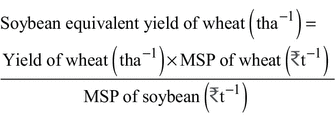
System productivity was calculated by adding the soybean yield and soybean equivalent yield of the wheat for the respective years.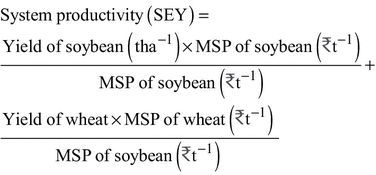
The minimum support price (MSP) was for soybean (₹ 34,000 t−1 and ₹ 37,000 t−1) and wheat (₹ 18,400 t−1 and ₹ 19,250 t−1) during the year 2018–19 and 2019–20, respectively. 1 USD ($) = 82 INR (₹).
2.6. Statistical analysis
The data presented in this study were pooled from both years and analyzed using two-way analysis of variance (ANOVA) in Statistical Analysis Software v9.4 (SAS Institute, 2016; Supplementary Table S1) and R statistical software (R Core Team, 2016). The relationship between various treatment scenarios and variables was calculated, and the variables were classified based on stability and mean (Yan and Kang, 2002). The effect of different treatments on soil chemical properties was analyzed using a biplot analysis through principal component (PC) with the support of R Studio (RStudio Team, 2014). A Pearson’s correlation matrix (correlogram) was constructed to determine the degree of correlation between the tested soil variables.
3. Results and discussion
3.1. Soil physical properties
It was observed that the effects of different management practices on soil bulk density (BD), particle density (PD), and porosity under the soybean-wheat cropping system were non-significant (p > 0.05; Table 2). However, the conservation organic crop management practice resulted in a reduction of BD (1.2 Mg m−3) and subsequently increased soil porosity (51.8%) at the topsoil (0–15 cm). Previous studies have shown that minimum tillage and the application of organic manures for many consecutive years can reduce soil bulk density and increase porosity (Govaerts et al., 2009; Gathala et al., 2011). Soil bulk density is an important indicator of changes in soil physical condition and water holding capacity due to different tillage practices (Jin et al., 2007). Alam et al. (2014) observed a significant reduction in soil bulk density under zero tillage, minimum tillage, conventional tillage, and deep tillage when compared to initial values, which supports the results of our study.
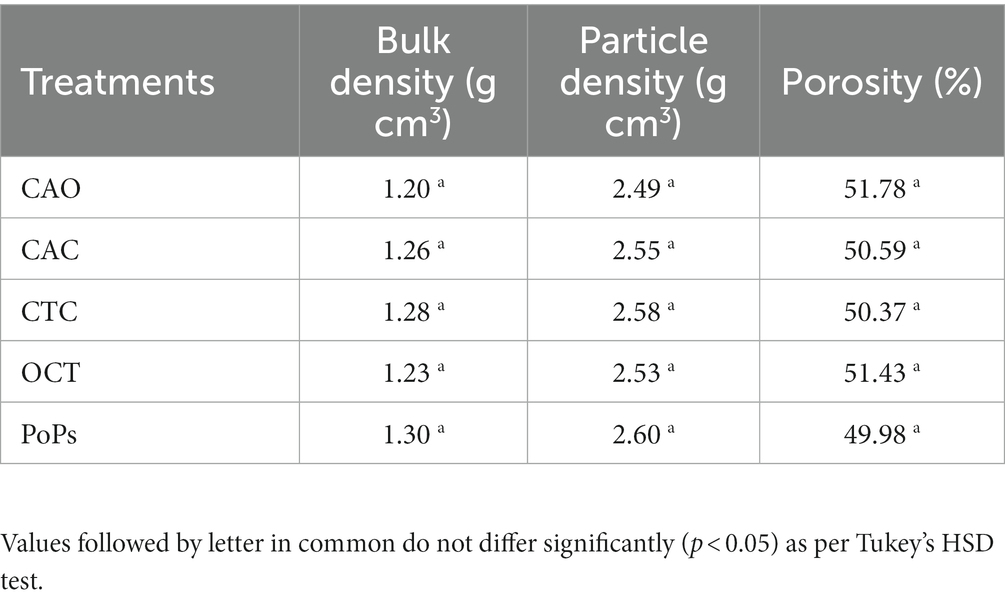
Table 2. Physical properties of soil as influenced by tillage, nutrient and weed management practices.
3.2. Soil physico-chemical properties
Unlike soil physical properties, tillage and crop management practices had significant influence (p < 0.05) on soil physico-chemical properties involving pH, EC, and SOC (Figures 2A–C). Conservation organic (CAO) and OCT resulted in lowering pH towards neutrality. Similarly organic management (CAO and OCT) significantly reduced EC as compared to CTC and PoPs. There was an increasing trend in pH and along the soil depths, irrespective of the treatments. Averaged across the depths, although CAO and OCT recorded higher CEC but remained at par with other treatments (Figure 2D). SOC showed a depleting trend along with increasing soil depth across the treatments (Figure 2). At 0–15 cm, the highest SOC was recorded under conservation organic (6.8 g kg−1) followed by organic management + conventional tillage (6.6 g kg−1), and the least was observed in the package of practices (5.6 g kg−1). A similar trend was also noticed for other soil depths. Averaged over the soil depths, conservation organic (CAO) recorded 16.3% higher SOC as compared to PoPs over 2 years of experimentation.
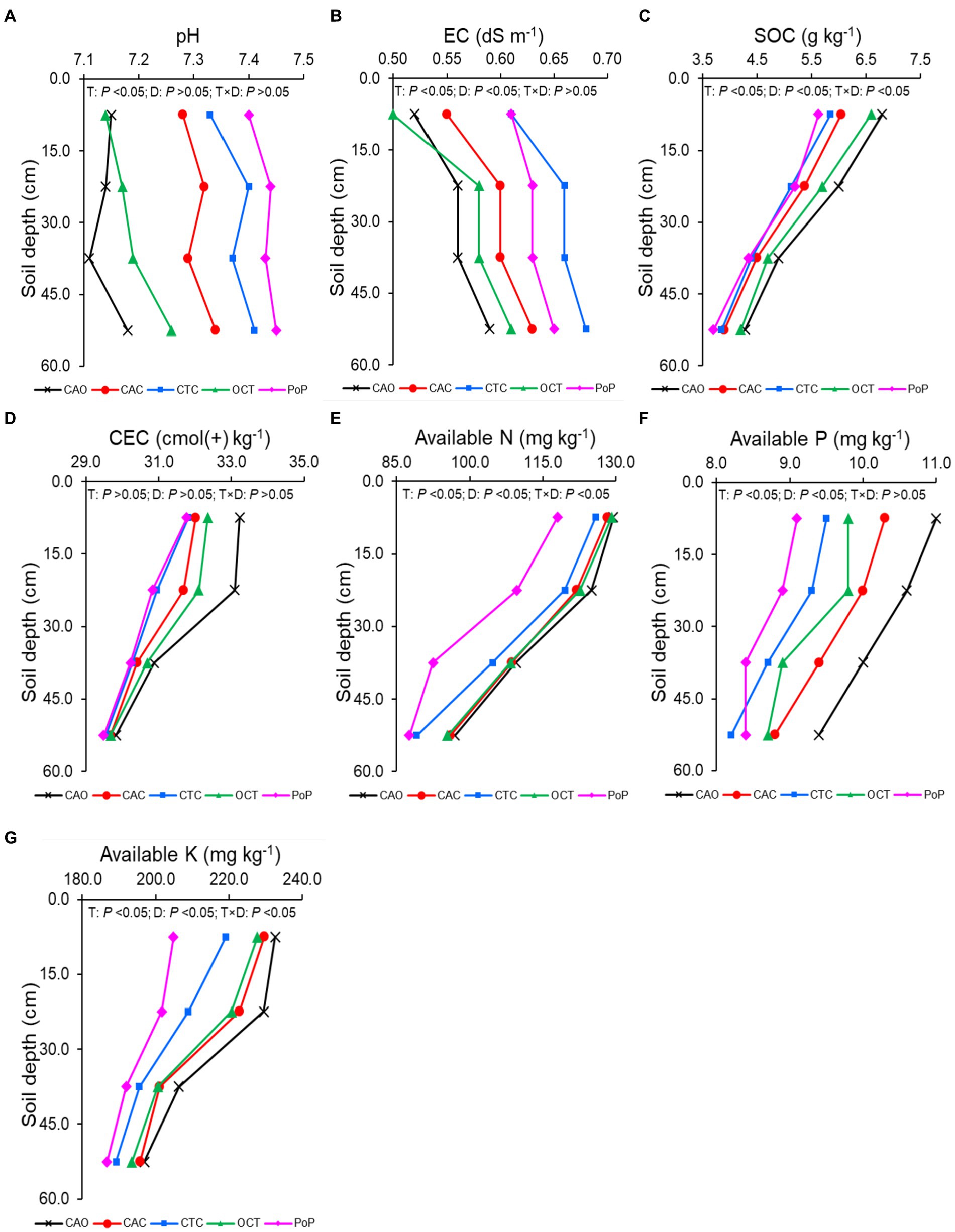
Figure 2. Depth-wise variation in the soil physico-chemical properties [(A)-pH; (B)-EC; (C)-SOC and (D)-CEC] and availability of primary nutrients [(E)-available N; (F)-available P and (G)- available K] as influenced by tillage, nutrient and weed management practices. Statistical significance (p < 0.05) was tested for treatment (T), soil depth (D) and treatment × soil depth (T × D). EC: electrical conductivity; SOC: soil organic C.
Organic carbon in soil ecosystem is mostly controlled through a complex interaction between soil edaphic factors and land husbandry (Yadav et al., 2020). Residues and dead-decaying debris of crops are the main contributor to the organic carbon accumulation in the soil (Lal, 2004). Previous reports indicated that SOC can be increased by reduced tillage (Neugschwandtner et al., 2014) and by crop residues retention (Hati et al., 2015). Onward 60 cm depth, significant increase in SOC under CAO might be due to relatively high quantity of organic inputs through FYM and minimal soil disturbance resulting better permanency of soil organic matter (Hati et al., 2015; Mohanty et al., 2020; Yadav et al., 2020). A likewise increment in SOC under OCT again suggests that SOC accrual was chiefly governed by FYM addition rather than by tillage practices. Earlier, Meena et al. (2019) also demonstrated that FYM addition can significantly increase SOC content in the soil. Apart from increasing SOC, continuous addition of high quantity of FYM can also decrease soil pH (Hao and Chang, 2002; Rayne and Aula, 2020) by lowering the conductance, which corroborates our observation. On the other side, increase in CEC under CAO and OCT may be attributed to the presence of organic matter in manure that decomposes to increase the negatively charged sites on carboxyl and phenolic hydroxyl groups (Hao and Chang, 2002; Miller et al., 2016).
3.3. Availability of primary nutrients
Tillage and crop management had a significant (p < 0.05) impact on the availability of primary nutrients (N, P, and K) as shown in (Figures 2E–G). The CAO crop management treatment had the highest availability of primary nutrients across all soil depths and was significantly (p < 0.05) higher than the PoPs treatment. Compared to PoPs, the CAO and CAC treatments showed about a 10.0% increase in N availability. Nitrogen availability decreased across all treatments from 126.2 (0–15 cm) to 89.9 mg kg−1 (45–60 cm). Similarly, compared to CTC and PoPs, conservation tillage with organic and chemical management greatly increased the availability of P (7.9 to 14.7%) and K (5.5 to 7.4%). This is further illustrated in the biplot analysis (Figure 3). Additionally, the availability of P and K decreased with increasing soil depth across all treatments. On the other hand, a strong positive correlation between SOC and the availability of primary nutrients was observed (Figure 4).
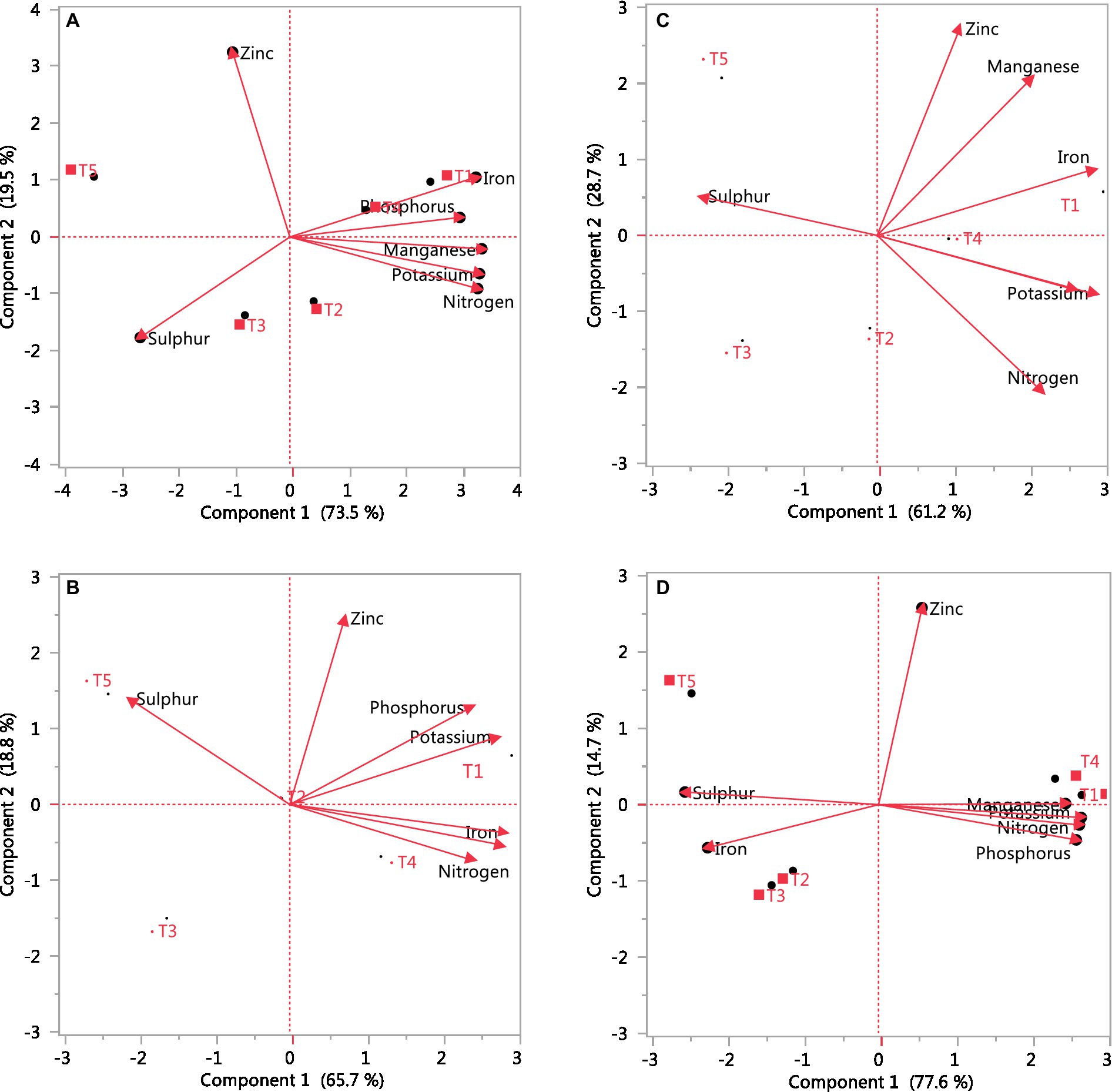
Figure 3. PCA biplot analysis of treatment effects (tillage, nutrient and weed management) on soil chemical properties. (A) 0–15 cm; (B) 15–30 cm; (C) 30–45 cm; (D) 45–60 cm. The abbreviation section includes key to the label of treatments.
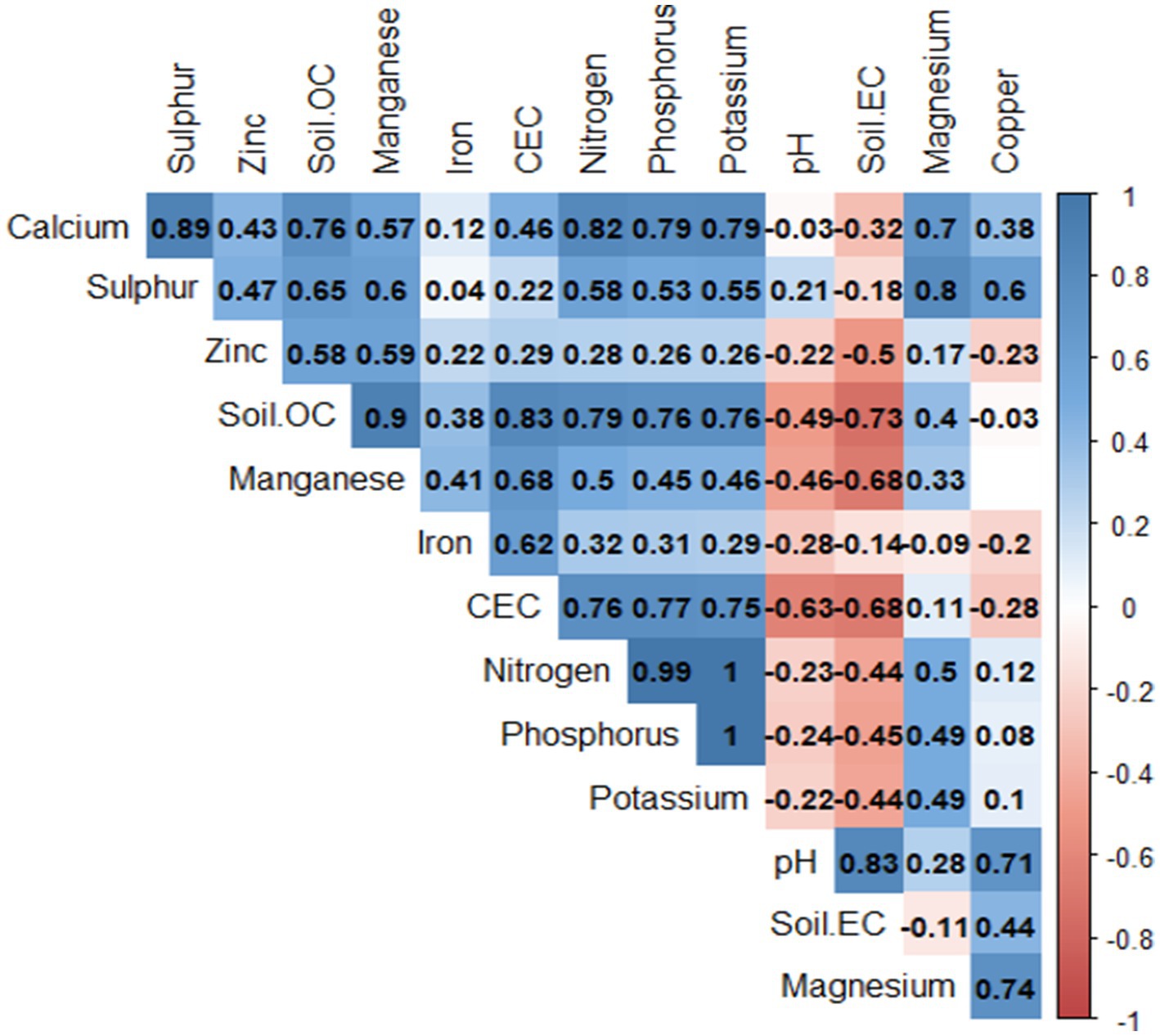
Figure 4. Correlogram (Pearson) of different soil fertility parameters as affected by tillage, nutrient and weed management practices.
The higher availability of in conservation tillage with organic and inorganic nutrient and weed management may be attributed to the increased supply of organic matter and improved soil ecosystem for nutrient cycling. Organic manures, in general, act as slow-release fertilizers, and their decomposition leads to an enhanced availability of nutrients (Mandal et al., 2000; Meena et al., 2019). Previous studies have shown that combining N fertilizer with quality crop residues can have a positive interactive effect on mineral N (Gentile et al., 2008). In contrast, straw incorporation in soil has been found to increase microbial biomass and N mineralization, leading to a higher nutrient supply in soil (Eagle et al., 2000; Choudhary et al., 2018; Dhaliwal et al., 2023b). These observations suggest that both organic and inorganic nutrient management can increase nutrient availability in soils, supporting our findings. Additionally, changes in SOC due to tillage practices can influence N content, with conventional tillage resulting in greater losses due to frequent tillage, higher leaching, and mineralization losses (Lal, 1997; Cui et al., 2023). This may explain the lower N availability observed under CTC.
Again, higher availability of N and P was observed in surface soil under zero tillage and minimum tillage. The build-up of available P in soil is attributed to its constrained downward movement, as reported in previous studies (NzeMemiaghe et al., 2022). The higher availability of K and P under conservation and organic management practices might be attributed to reduced fixation or solubilization of fixed forms due to the higher prevalence of organic acids as well as mineralization of added organic manure, as reported in previous investigations (Yadav and Kumar, 2002; Berner et al., 2008; Mahanta and Rai, 2008; Elayarajan et al., 2015; Meena et al., 2019). Moreover, mobilization of non-exchangeable K into the soil solution might have increased its availability in the soil under conservation and organic management practices (Venkatesh et al., 2017). Simultaneous increase in soil organic carbon and availability of nutrients with crop residue amendments has also been reported in soybean (Singh and Rai, 2004) and is in line with our observation on positive correlation between SOC and primary nutrients.
3.4. Availability of secondary- and micro-nutrients
The availability of Ca, Mg, S, (Figures 5A–C) and micronutrients (Figures 5D–G - available Zn, Fe, Cu, and Mn) at different soil depths was significantly (p < 0.05) affected by tillage and crop management practices (Figure 5). The CAC treatment showed the highest availability of exchangeable Ca and Mg, which was significantly (p < 0.05) higher than the CAO and OCT treatments. Conversely, S availability was comparable between CAC and PoPs but remained significantly (p < 0.05) higher than the other treatments. Notably, the least availability of secondary nutrients was observed in OCT. Zinc availability was significantly (p < 0.05) higher with PoPs, followed by CAO (Figure 5). Furthermore, Fe and Mn availability increased by 6.5 and 17.3%, respectively, with CAO compared to PoPs management. However, Cu availability was significantly (p < 0.05) higher with CAC than the other treatments. Similar to primary nutrients, the availability of secondary and micronutrients also decreased with increasing soil depth across all treatments. Apart from the availabilities, a close view of the biplot graphs revealed distinct position of S and Zn across the soil depths (Figure 3).
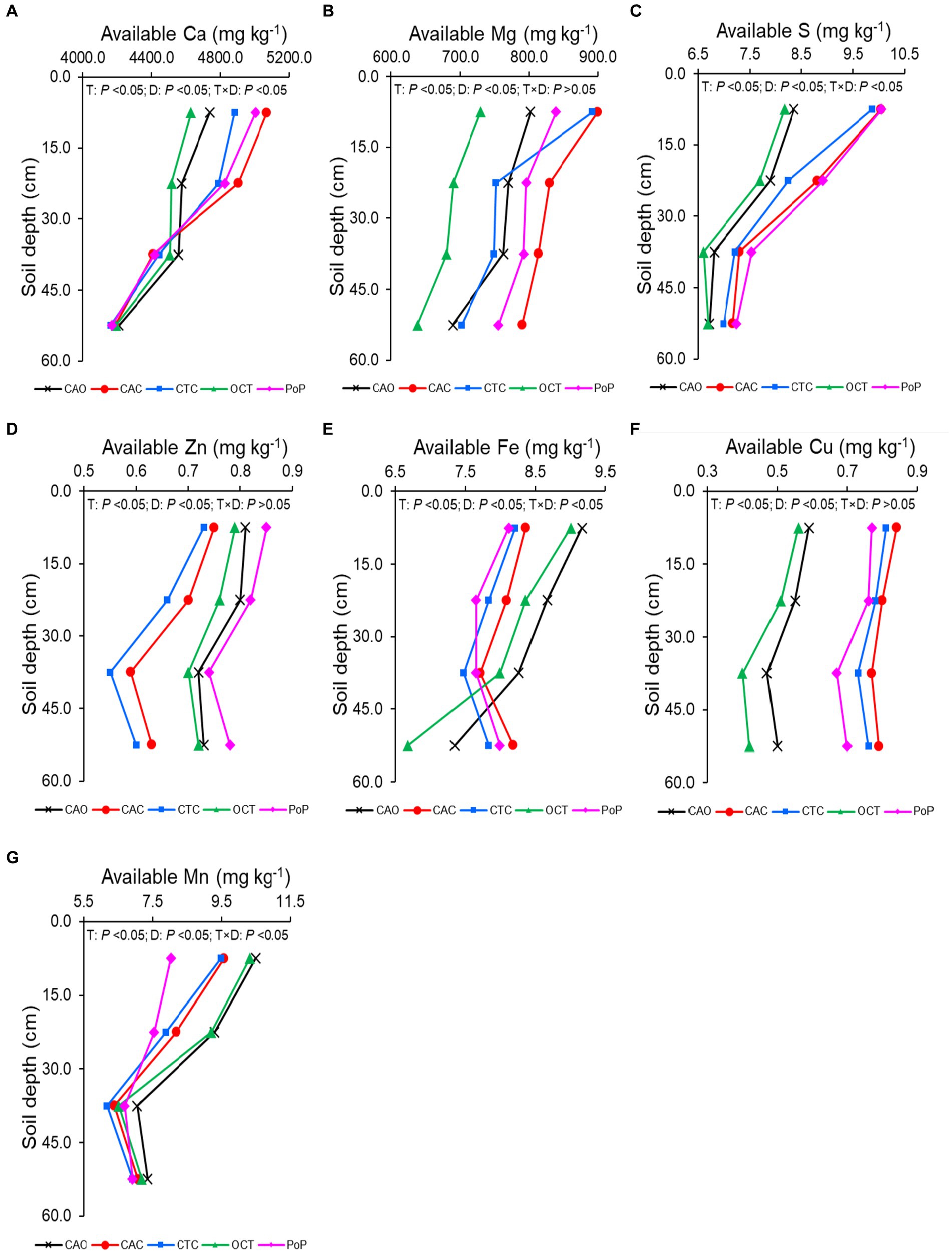
Figure 5. Depth-wise variation in the availability of secondary [(A)-available Ca; (B)-available Mg and (C)- available S] and micro-nutrients nutrients as [(D)- available Zn; (E)-available Fe; (F)- available Cu and (G)-available Mn] influenced by tillage, nutrient and weed management practices. Statistical significance (p < 0.05) was tested for treatment (T), soil depth (D) and treatment × soil depth (T × D).
Overall, the availability of secondary and micronutrients in the soil was greatly improved by the addition of nutrients from organic and inorganic sources, as well as by tillage practices that affected both the quantity and mineralization of nutrients in the soil. Our results support the findings of Gadana et al. (2020), who also reported a positive impact of soil management practices on exchangeable cations and soil micronutrients. Crop residue retention and the addition of organic manure and mineral fertilizers provided an added advantage for better microbial growth, which accelerated nutrient mineralization and led to enhanced nutrient availability (Kiboi et al., 2021). It is worthy to note that the availability of secondary nutrients remained high for the treatments receiving chemical fertilizers in conjunction with manure. In this study, we used single superphosphate as the P source, which contains a fairly high quantity of Ca and S (Barker, 2019). Therefore, the increased availability of these nutrients in chemically fertilized plots is not surprising.
Regardless of the management practices, the soil in this study showed high availability of micronutrients in comparison to the critical limits identified for Indian soils (Katyal and Sharma, 1991; Debnath et al., 2022), which contrasts with the marginal to medium status of available Fe and Zn and the medium to high status of available Mn and Cu concentration in farmed Vertisol parcels in India (Somasundaram et al., 2009). Therefore, conservation tillage coupled with organic nutrient management may be a sustainable practice to maintain the availability of micronutrients in the soils of this region. However, their removal from crop biomass with continuous cropping may decrease their phytoavailability in soils in the future. Periodical soil testing may thus help to decipher their depletion in soil so as to undertake appropriate remedial measures. Distinct position of S and Zn in biplots suggests their role as key indicators of sustaining soil health in the soybean–wheat systeam in arid ecology. Therefore, periodic monitoring of their availability remains indispensable to avoid yield trade-offs due to their short supply.
Compared to the 30–45 cm depth, a slightly higher availability of micronutrients was observed at the 45–60 cm depth, possibly due to leaching from the upper layer and accumulation at a later soil depth. However, this effect was absent for secondary nutrients, suggesting their leaching into deeper soil layers. This indicates that the leaching of micronutrients into deeper soil layers was possibly prevented by the formation of organo-mineral complexes or chelation due to organic inputs and increased soil organic matter (SOM). The higher availability of Zn with PoPs and CAO may be due to Zn application and organic matter addition, respectively. Our results also suggest that conservation tillage had a significant effect on Fe availability. Similarly, Jayaraman et al. (2021b) reported that available Fe concentration was relatively higher under no-till than conventional tillage in vertisols of Central India. The hierarchical clustering analysis of different soil properties suggests that organic matter addition has significantly improved the availability of Cu and Mn (Figure 6).
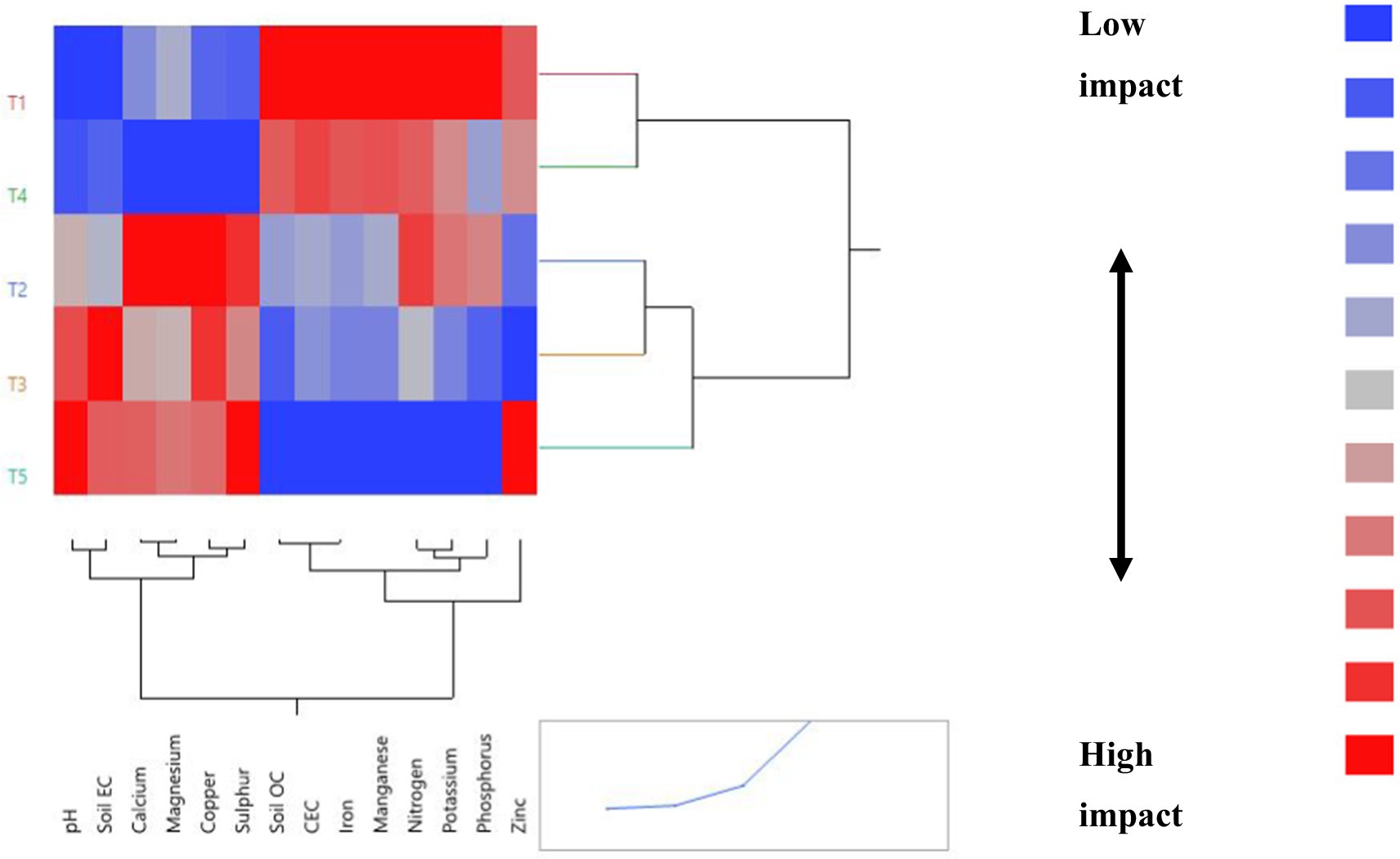
Figure 6. Hierarchical clustering of different soil chemical properties as affected by tillage, nutrient and weed management practices.
3.5. System productivity of cropping system
The soybean-wheat cropping system registered the maximum system productivity (SEY) in CAC with a yield of 4.62 t ha−1, which was significantly higher by 13.96 and 18.17% compared to CAO and OCT, respectively (Table 3). However, SEY of CAC and PoPs was statistically similar. Although nutrient availability increased with organic nutrient management combined with conservation or conventional tillage practices, it did not enhance SEY. This suggests that other factors may have influenced the yields of different treatments. Kravchenko Alexandra et al. (2017) also reported yield penalties of 10–30% under organic management during the initial years. Effective weed management and timely availability of nutrients to the crop under CAC could be the prominent reasons for comparatively higher yields. Tillage operation, nutrient management, and leguminous crops can significantly influence crop yields in a cropping system (Alam et al., 2020). Meena et al. (2022a, 2022b) also reported that CAC evolved as a better crop management practice under the soybean-wheat cropping system, producing the maximum economic yield of soybean over a regime of practice involving the recommended package of practices: conventional tillage + chemical, conservation tillage + organic, and conventional tillage + organic nutrient management.
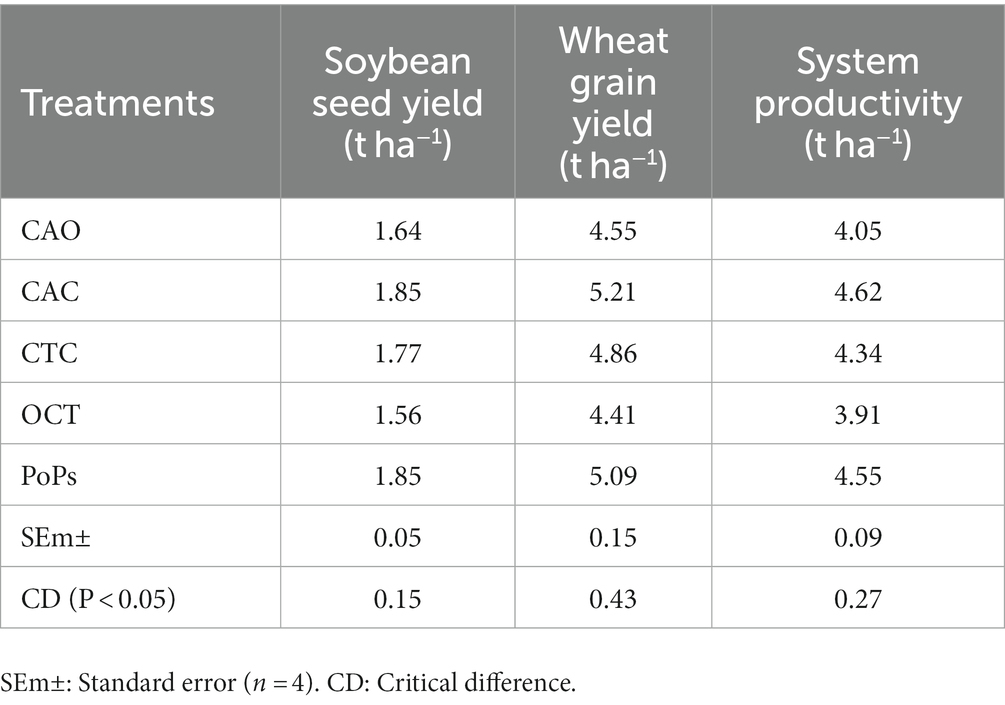
Table 3. Yield and system productivity of soybean-wheat cropping system as influenced by tillage, nutrient, and weed management practices.
4. Conclusion
Our study highlights the importance of the soybean-wheat cropping system for improving soil fertility and ensuring sustainable yields. Organic nutrient and weed management, combined with conservation or conventional tillage, improved soil fertility attributes such as SOC, N, P, K, Ca, Mg, Zn, and Fe but had no significant impact on soil physical characteristics. However, the effects of these management practices on soil fertility attributes were predominantly limited to topsoil (0–15 cm) alone. Our results clearly demonstrated that SOC accrual in the soil was primarily governed by organics addition rather than by tillage practices. Again, the results elucidated S and Zn as key indicators of sustaining soil health in the soybean–wheat systeam of arid ecology and therefore, warrants periodic monitoring of their availability to circumvent yield trade-offs, if there be any, due to their deficiency. The highest system productivity was achieved through the use of chemical herbicides and fertilizers in conjunction with conservation tillage (CAC), which is likely due to effective weed control and instantaneous nutrient availability. Nevertheless, adoption of conservation tillage with organic nutrients and weed management technology can be a long-term strategy for sustaining soil fertility under soybean-wheat cropping system in arid to semiarid ecology, which may help ensuring global food security in the future.
Data availability statement
The original contributions presented in the study are included in the article/Supplementary material, further inquiries can be directed to the corresponding author.
Author contributions
SN: implementation of field experiment, observation recording, monitoring, and other management practices related to study. SS: designed the study and guidance. AR, BM, DJ, SD, and DS: manuscript writing, edition and statistical analysis and interpretation of data; DJ and SM: editing and interpretation of results. SY, PV, UD, JM, and SN: technical help, contributed in sample analysis, soil analysis, and drafting. PS: conceptualize the study and guidance during study. All authors contributed to the article and approved the submitted version.
Funding
This study was funded by Agriculture University, Kota and MPUA&T, Udaipur, Rajasthan, India.
Acknowledgments
Authors are appreciative to Agriculture University, Kota and MPUA&T, Udaipur, for providing financial, technical, and necessary facilities during the study period and successfully conducting this research work. DJ acknowledges the financial support from IDP, NAHEP, ICAR, New Delhi for International training.
Conflict of interest
The authors declare that the research was conducted in the absence of any commercial or financial relationships that could be construed as a potential conflict of interest.
Publisher’s note
All claims expressed in this article are solely those of the authors and do not necessarily represent those of their affiliated organizations, or those of the publisher, the editors and the reviewers. Any product that may be evaluated in this article, or claim that may be made by its manufacturer, is not guaranteed or endorsed by the publisher.
Supplementary material
The Supplementary material for this article can be found online at: https://www.frontiersin.org/articles/10.3389/fsufs.2023.1234344/full#supplementary-material
References
Alam, M. K., Bell, R. W., Haque, M. E., Islam, M. A., and Kader, M. A. (2020). Soil nitrogen storage and availability to crops are increased by conservation agriculture practices in rice–based cropping systems in the eastern Gangetic Plains. Field Crop Res. 250:107764. doi: 10.1016/j.fcr.2020.107764
Alam, M. K., Islam, M. M., Salahin, N., and Hasanuzzaman, M. (2014). Effect of tillage practices on soil properties and crop productivity in wheat-mungbean-rice cropping system under subtropical climatic conditions. Sci. World J. 2014, 1–15. doi: 10.1155/2014/437283
Barker, A. V. (2019). “Fertilizers” in Encyclopedia of analytical science. 3rd ed (Cambridge, MA, USA: Academic Press), 134–144.
Behera, U. K., Sharma, A. R., and Pandey, H. N. (2007). Sustaining productivity of wheat–soybean cropping system through integrated nutrient management practices on the Vertisols of Central India. Plant Soil 297, 185–199. doi: 10.1007/s11104-007-9332-3
Berner, A., Hildermann, I., FlieBbach, A., Pfiffner, L., Niggli, U., and Mader, P. (2008). Crop yield and soil fertility response to reduced tillage under organic management. Soil Tillage Res. 101, 89–96. doi: 10.1016/j.still.2008.07.012
Bhan, S., and Behra, U. K. (2014). Conservation agriculture in India- problems, prospects and policy issues. Int. Soil Water Conserv. Res. 2, 1–12. doi: 10.1016/S2095-6339(15)30053-8
Blake, G. R., and Hartge, K. H. (1986). “Bulk density” in Methods of soil analysis part 1. Physical and mineralogical methods. ed. A. Klute, Agronomy, vol. 9. 2nd ed (Madison, WI: American Society of Agronomy), 363–382.
Carpenter-Boggs, L., Stahl, P. D., Lindstrom, M. J., and Schumacher, T. E. (2003). Soil microbial properties under permanent grass, conventional tillage and no till management in south Dokota. Soil Tillage Res. 71, 15–23. doi: 10.1016/S0167-1987(02)00158-7
Chesnin, L., and Yien, C. H. (1950). Turbidimetric determination of available sulphates. Soil Sci. Soc. Am. J. 15, 149–151. doi: 10.2136/sssaj1951.036159950015000C0032x
Choudhary, M., Panday, S. C., Meena, V. S., Singh, S., Yadav, R. P., Mahanta, D., et al. (2018). Long-term effects of organic manure and inorganic fertilization on sustainability and chemical soil quality indicators of soybean-wheat cropping system in the Indian mid-Himalayas. Agric. Ecosyst. Environ. 257, 38–46. doi: 10.1016/j.agee.2018.01.029
Cui, H., Luo, Y., Li, C., Chang, Y., Jin, M., Li, Y., et al. (2023). Improving soil fertility and wheat yield by tillage and nitrogen management in winter wheat–summer maize cropping system. Agronomy 13:740. doi: 10.3390/agronomy13030740
Dal Ferro, N., Stevenson, B., Morari, F., and Muller, K. (2023). Long-term tillage and irrigation effects on aggregation and soil organic carbon stabilization mechanisms. Geoderma 432:116398. doi: 10.1016/j.geoderma.2023.116398
Debnath, S., Narayan, R., Kumar, A., Kishor, A., and Singh, D. B. (2020). Are horticulture-based land uses benign for fertility and health of soils in mid to high hills of the north-western Himalayan region? J. Soil Sci. Plant Nutr. 66, 489–498. doi: 10.1080/00380768.2020.1753110
Debnath, S., Purakayastha, T. J., Kishor, A., Kumar, A., and Bhowmik, A. (2022). Temperate fruit farming in fragile lands of the Northwestern Himalayan region: implications for subsoil nutrient availability, nutrient stock and soil quality. Land Degrad De. 33, 3484–3496. doi: 10.1002/ldr.4402
Dev, I., Singh, R., Garg, K. K., Ram, A., Singh, D., Kumar, N., et al. (2022). Transforming livestock productivity through watershed interventions: a casestudy of Parasai-Sindh watershed in Bundelkhand region of Central India. Agric. Syst. 196:103346. doi: 10.1016/j.agsy.2021.103346
Devi, K. N., Singh, T. B., Athokopam, H. S., Singh, N. B., and Shamurailatpam, D. (2013). Influence of inorganic, biological and organic manures on nodulation and yield of soybean (Glycine max Merrill L.) and soil properties. Aust. J. Crop. Sci. 7, 1407–1415.
Dhaliwal, S. S., Sharma, V., Shukla, A. K., Gupta, R. K., Verma, V., Kaur, M., et al. (2023a). Residual effect of organic and inorganic fertilizers on growth, yield and nutrient uptake in wheat undera basmati rice–wheat cropping system in North-Western India. Agriculture 13:556. doi: 10.3390/agriculture13030556
Dhaliwal, S. S., Sharma, V., Shukla, A. K., Verma, V., Kaur, M., Singh, P., et al. (2023b). Effect of addition of organic manures on basmati yield, nutrient content and soil fertility status in North-Western India. Heliyon 9:e14514. doi: 10.1016/j.heliyon.2023.e14514
Eagle, A. J., Bird, J. A., Horwath, W. R., Linquist, B. A., Brouder, S. M., Hill, J. E., et al. (2000). Rice yield and nitrogen utilization efficiency under alternative straw management practices. J. Agron. 92, 1096–1103. doi: 10.2134/agronj2000.9261096x
Elayarajan, M., Sathya, S., and Arulmozhiselvan, K. (2015). Effect of inorganic fertilizers and organic manures on yield and nutrient uptake by maize hybrid under maize-sunflower cropping sequence in Typic Haplustalf. Karnataka J. Agric. Sci. 28, 29–33.
Gadana, D. B., Sharma, P. D., and Selfeko, D. T. (2020). Effect of soil management practices and slope on soil fertility of cultivated lands in Mawula watershed, Loma district, southern Ethiopia. Adv. Agric. 2020, 1–13. doi: 10.1155/2020/8866230
Garg, K. K., Akuraju, V., Anantha, K. H., Singh, R., Whitbread, A. M., and Dixit, S. (2022). Identifying potential zones for rainwater harvesting interventions for sustainable intensification in the semi-arid tropics. Sci. Rep. 12, 3882–3818. doi: 10.1038/s41598-022-07847-4
Gathala, M. K., Ladha, J. K., Saharawat, Y. S., Kumar, V., Kumar, V., and Sharma, P. K. (2011). Effect of tillage and crop establishment methods on physical properties of a medium textured soil under a seven-year rice−wheat rotation. Soil Sci. Soc. Am. J. 75, 1851–1862. doi: 10.2136/sssaj2010.0362
Gentile, R., Vanlauwe, B., Chivenge, P., and Six, J. (2008). Interactive effects from combining fertilizer and organic residue inputs on nitrogen transformations. Soil Biol. Biochem. 40, 2375–2384. doi: 10.1016/j.soilbio.2008.05.018
Govaerts, B., Mezzalama, M., Unno, Y., Sayre, K. D., Luna-Guido, M., Vanherck, K., et al. (2007). Influence of tillage, residue management, and crop rotation on soil microbial biomass and catabolic diversity. Appl. Soil Ecol. 37, 18–30. doi: 10.1016/j.apsoil.2007.03.006
Govaerts, B., Sayre, K. D., Goudeseune, B., de Corte, P., Lichter, K., Dendooven, L., et al. (2009). Conservation agriculture as a sustainable option for the central Mexican highlands. Soil Tillage Res. 103, 222–230. doi: 10.1016/j.still.2008.05.018
Hao, X., and Chang, C. (2002). Effect of 25 annual cattle manure application on soluble and exchangeable cations in soil. Soil Sci. 167, 126–134. doi: 10.1097/00010694-200202000-00005
Hati, K. M., Chaudhary, R. S., Mandal, K. G., Bandyopadhyay, K. K., Singh, R. K., Sinha, N. K., et al. (2015). Effects of tillage, residue and fertilizer nitrogen on crop yields, and soil physical properties under soybean–wheat rotation in vertisols of Central India. Agric. Res. 4, 48–56. doi: 10.1007/s40003-014-0141-7
Jalota, S. K., Khera, R., and Chahal, S. S. (2001). Straw management and tillage effects on soil water storage under field conditions. Soil Use Manag. 17, 282–287. doi: 10.1079/SUM200193
Jayaraman, S., Dang, Y. P., Naorem, A., Page, K. L., and Dalal, R. C. (2021a). Conservation agriculture as a system to enhance ecosystem services. Agriculture 11:718. doi: 10.3390/agriculture11080718
Jayaraman, S., Sinha, N. S., Mohanty, M., Hati, K. M., Chaudhary, R. S., Shukla, A. K., et al. (2021b). Conservation tillage, residue management, and crop rotation effects on soil major and micro-nutrients in semi-arid Vertisols of India. J. Soil Sci. Plant Nutr. 21, 523–535. doi: 10.1007/s42729-020-00380-1
Jha, S. K., Mishra, V. K., Damodaran, T., Singh, A. K., Sharma, P. C., Sharma, D. K., et al. (2023). Conservation tillage and waste crop residue based zinc fortification in rice and wheat under reclaimed sodic soils: progress toward nutrient circularity and sustainability. J. Agric. Food Chem. 71, 2853–2863. doi: 10.1021/acs.jafc.2c07940
Jin, H., Hongwen, L., Xiaoyan, W., McHugh, A. D., Wenying, L., Huanwen, G., et al. (2007). The adoption of annual subsoiling as conservation tillage in dryland maize and wheat cultivation in northern China. Soil Tillage Res. 94, 493–502. doi: 10.1016/j.still.2006.10.005
Kätterer, T., and Bolinder, M. A. (2023). “Agriculture practices to improve soil carbon storage in upland soil” in Understanding and fostering soil carbon sequestration. ed. C. Rumpel (Cambridge, UK: BurleighDodds Science Publishing), 453–488.
Katyal, J. C., and Sharma, B. D. (1991). DTPA extractable and total Zn, cu, Mnand Fe in Indian soils and their association with some soil properties. Geoderma 49, 165–179. doi: 10.1016/0016-7061(91)90099-F
Kiboi, M. N., Ngetich, F. K., Mucheru-Muna, M. W., Diels, J., and Mugendi, D. N. (2021). Soil nutrients and crop yield response to conservation-effective management practices in the sub-humid highlands agro-ecologies of Kenya. Heliyon 7:e07156. doi: 10.1016/j.heliyon.2021.e07156
Kravchenko Alexandra, N., Snapp Sieglinde, S., and Philip, R. G. (2017). Field-scale experiments reveal persistent yield gaps in low-input and organic cropping systems. PNAS 114, 926–931. doi: 10.1073/pnas.1612311114
Lal, R. (1997). Long-term tillage and maize monoculture effects on a tropical alfisol in western Nigeria. II soil chemical properties. Soil Tillage Res. 42, 161–174. doi: 10.1016/S0167-1987(97)00007-X
Lal, R. (2004). Soil carbon sequestration impacts on global climate change and food security. Science 304, 1623–1627. doi: 10.1126/science.1097396
Lenka, S., Lenka, N. S., Singh, A. B., Singh, B., and Raghuwanshi, J. (2016). Global warming potential and greenhouse gas emission under different soil nutrient management practices in soybean–wheat system of Central India. Environ. Sci. Pollut. Res. 24, 4603–4612. doi: 10.1007/s11356-016-8189-5
Lindsay, W., and Norvell, W. A. (1978). Development of DTPA soil test for Zn, Fe, Mn and cu. Soil Sci. Soc. Am. J. 42, 421–428. doi: 10.2136/sssaj1978.03615995004200030009x
Mahanta, D., and Rai, R. K. (2008). Effects of sources of phosphorus and biofertilizers on productivity and profitability of soybean (Glycine max)–wheat (Triticum aestivum) system. Indian J. Agron. 53, 279–284.
Mandal, K. G., Misra, A. K., and Hati, K. M. (2000). Effect of combination of NPK and FYM on growth, yield and agronomic efficiency of soybean (Glycine max) in vertisol. Environ. Ecol. 18, 207–209.
Manna, M. C, Subba Rao, A., Sahu, A., and Singh, U. B. (2012) Compost handbook: Research-production-application. Fertiliser Development and Consultation Organisation, New Delhi.
Meena, B. P., Biswas, A. K., Singh, M., Chaudhary, R. S., Singh, A. B., Das, H., et al. (2019). Long-term sustaining crop productivity and soil health in maize–chickpea system through integrated nutrient management practices in Vertisols of Central India. Field Crop Res. 232, 62–76. doi: 10.1016/j.fcr.2018.12.012
Meena, S. N., Sharma, S. K., Jadon CK, S. P., Jat, M. L., and Meena, R. L. (2022b). Crop-management practices influence weed dynamics, yield and economics of soybean (Glycine max). Indian J. Agron. 67, 282–286.
Meena, S. N., Sharma, S. K., Singh, P., Meena, B. P., Jat, M. L., Jadon, C. K., et al. (2022a). Growth and yield of soybean [Glycine max (L.) Merr.] influenced by various crop management practices. Arch. l'anthropologie Criminelle Sci. Pénales 14, 34–38. doi: 10.5958/2394-4471.2022.00006.5
Miller, J., Beasley, B., Drury, C., Larney, F., and Hao, X. (2016). Influence of long-term application of composted or stockpiled feedlot manure with straw or wood chips on soil cation exchange capacity. Compost. Sci. Util. 24, 54–60. doi: 10.1080/1065657X.2015.1055009
Mohanty, M., Sinha, N. K., Somasundaram, J., McDermid, S. S., Patra, A. K., Singh, M., et al. (2020). Soil carbon sequestration potential in a vertisol in Central India-results from a 43-year long-term experiment and APSIM modeling. Agric. Syst. 184:102906. doi: 10.1016/j.agsy.2020.102906
NAAS (2017) Sustaining soybean productivity and Productionin India. National Academy of Agricultural Sciences, New Delhi, pp. 52.
Neugschwandtner, R. W., Liebhard, P., Kaul, H. P., and Wagentristl, H. (2014). Soil chemical properties as affected by tillage and crop rotation in a long-term field experiment. Plant Soil Environ. 60, 57–62. doi: 10.17221/879/2013-PSE
NMOOP (2014). Status Paper on Oilseeds. National Mission on Oilseeds, Krishi Bhavan, NewDelhi, pp.14.
NzeMemiaghe, J. D., Cambouris, A. N., Ziadi, N., and Karam, A. (2022). Tillage management impacts on soil phosphorus variability under maize–soybean rotation in eastern Canada. Soil Syst. 6:45. doi: 10.3390/soilsystems6020045
Olsen, S. R., Cole, C. V., Watanabe, F. S., and Dean, L. A. (1954). Estimation of available phosphorus in soils by extraction with sodium bicarbonate, USDA Cir. No. 939 NaHCO3. USDA 931, 1–19.
Pramanick, B., Kumar, M., Naik, B. M., Kumar, M., Singhm, S. K., Maitra, S., et al. (2022). Long-term conservation tillage and precision nutrient Management in Maize–Wheat Cropping System: effect on soil properties, crop production, and economics. Agronomy 12:2766. doi: 10.3390/agronomy12112766
R Core Team (2016). A language and environment for statistical computing. R Foundation for Statistical Computing.
Ramesh, K., Patra, A. K., and Biswas, A. K. (2017). Best management practices for soybean under soybean-wheat system to minimize the impact of climate change. Indian J. Fertilisers 13, 42–55.
Rani, K., Datta, A., Jat, H. S., Choudhary, M., Sharma, P. C., and Jat, M. L. (2023). Assessing the availability of potassium and its quantity-intensity relations under long term conservation agriculture based cereal systems in north-West India. Soil Tillage Res. 228:105644. doi: 10.1016/j.still.2023.105644
Rayne, N., and Aula, L. (2020). Livestock manure and the impacts on soil health: a review. Soil Syst. 4:64. doi: 10.3390/soilsystems4040064
Roos, E., Mie, A., Wivstad, M., Salomon, E., Johansson, B., Gunnarsson, S., et al. (2018). Risks and opportunities of increasing yields in organic farming-a review. Agron. Sustain. Dev. 38, 1–21. doi: 10.1007/s13593-018-0489-3
RStudio Team (2014). Studio: Integrated development for R. RStudio, Inc., Boston, MA (Computer Software v0.98.1074).
Schollenberger, C. J., and Simon, R. H. (1945). Determination of exchange capacity and exchangeable bases in soil – ammonium acetate method. Soil Sci. 59, 13–24. doi: 10.1097/00010694-194501000-00004
Sharma, S. K., Ravishankar, N., Chander, M., Jat, G., Choudhary, R., Fagodiya, R., et al. (2021). Organic agriculture under changing climatic scenario. Indian J. Agron. 66, S82–S94.
Singh, Y., Gupta, R. K., Singh, G., Singh, J., Sidhu, H. S., and Singh, B. (2009). Nitrogen and residue management effects on agronomic productivity and nitrogen use efficiency in rice–wheat system in Indian Punjab. Nutr. Cycl. Agroecosyst. 84, 141–154. doi: 10.1007/s10705-008-9233-8
Singh, R., and Rai, R. K. (2004). Yield attributes, yield and quality of soybean (Glycine max) as influenced by integrated nutrient management. Indian J. Agron. 49, 271–274.
Somasundaram, J., Singh, R. K., Parandiyal, A. K., and Prasad, S. N. (2009). Micronutrient status of soils under different land use systems in Chambal ravines. J. Indian Soc. Soil Sci. 57, 307–312.
Subbiah, B. V., and Asija, G. L. (1956). A rapid procedure for the estimation of available nitrogen in soils. Curr. Sci. 25, 259–260.
Venkatesh, M. S., Hazra, K. K., Ghosh, P. K., Khuswah, B. L., Ganeshamurthy, A. N., Ali, M., et al. (2017). Long–term effect of crop rotation and nutrient management on soil–plant nutrient cycling and nutrient budgeting in indo–Gangetic plains of India. Arch. Agron. Soil Sci. 63, 2007–2022. doi: 10.1080/03650340.2017.1320392
Walkley, A., and Black, I. A. (1934). An examination of the Degtjareff method for determining soil organic matter, and a proposed modification of the chromic acid titration method. Soil Sci. 37, 29–38. doi: 10.1097/00010694-193401000-00003
Yadav, G. S., Datta, R., Imran Pathan, S., Lal, R., Meena, R., Babu, S., et al. (2017). Effects of conservation tillage and nutrient management practices on soil fertility and productivity of rice (Oryza sativa L.)–rice system in north eastern region of India. Sustainability 9:1816. doi: 10.3390/su9101816
Yadav, D. S, and Kumar, A. (2002). Long-term effects of organic manures on productivity and soil fertility in rice-wheat cropping system. Extended summaries: 2nd international agronomy congress, Vol. 1 held at New Delhi, India from November 26–30. pp. 51–53.
Yadav, D., Shivay, Y. S., Singh, Y. V., Sharma, V. K., and Bhatia, A. (2020). Enhancing nutrient translocation, yields and water productivity of wheat under rice–wheat cropping system through zinc nutrition and residual effect of green manuring. J. Plant Nutr. 43, 2845–2856. doi: 10.1080/01904167.2020.1798997
Yan, W., and Kang, M. S. (2002). GGE Biplot analysis: a graphical tool for breeders, GGE Biplot Analysis: A Graphical Tool for Breeders, Geneticists, and Agronomists.
Zhao, Z., Mao, Y., Gao, S., Lu, C., Pan, C., and Li, X. (2023). Organic carbon accumulation and aggregate formation in soils under organic and inorganic fertilizer management practices in a rice–wheat cropping system. Sci. Rep. 13:3665. doi: 10.1038/s41598-023-30541-y
Keywords: conservation agriculture, nutrient availability, organic farming, soil depth, sustainability
Citation: Meena SN, Sharma SK, Singh P, Ram A, Meena BP, Jain D, Singh D, Debnath S, Yadav S, Dhakad U, Verma P, Meena JK and Nandan S (2023) Tillage-based nutrient management practices for sustaining productivity and soil health in the soybean-wheat cropping system in Vertisols of the Indian semi-arid tropics. Front. Sustain. Food Syst. 7:1234344. doi: 10.3389/fsufs.2023.1234344
Edited by:
Sudhakar Srivastava, Banaras Hindu University, IndiaReviewed by:
Abhay Shirale, National Bureau of Soil Survey and Land Use Planning (ICAR), IndiaBiswajit Pramanick, Dr. Rajendra Prasad Central Agricultural University, India
Copyright © 2023 Meena, Sharma, Singh, Ram, Meena, Jain, Singh, Debnath, Yadav, Dhakad, Verma, Meena and Nandan. This is an open-access article distributed under the terms of the Creative Commons Attribution License (CC BY). The use, distribution or reproduction in other forums is permitted, provided the original author(s) and the copyright owner(s) are credited and that the original publication in this journal is cited, in accordance with accepted academic practice. No use, distribution or reproduction is permitted which does not comply with these terms.
*Correspondence: Satya Narayan Meena, bWVlbmFzbmFncm9AZ21haWwuY29t; Asha Ram, YXNodXNpcnZpODRAZ21haWwuY29t
 Satya Narayan Meena
Satya Narayan Meena Shanti Kumar Sharma2
Shanti Kumar Sharma2 Asha Ram
Asha Ram Bharat Prakash Meena
Bharat Prakash Meena Devendra Jain
Devendra Jain Deepak Singh
Deepak Singh Sovan Debnath
Sovan Debnath